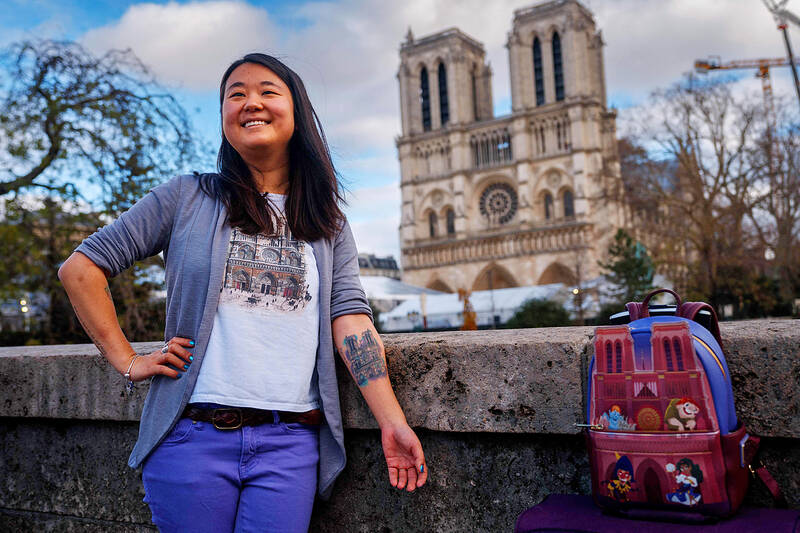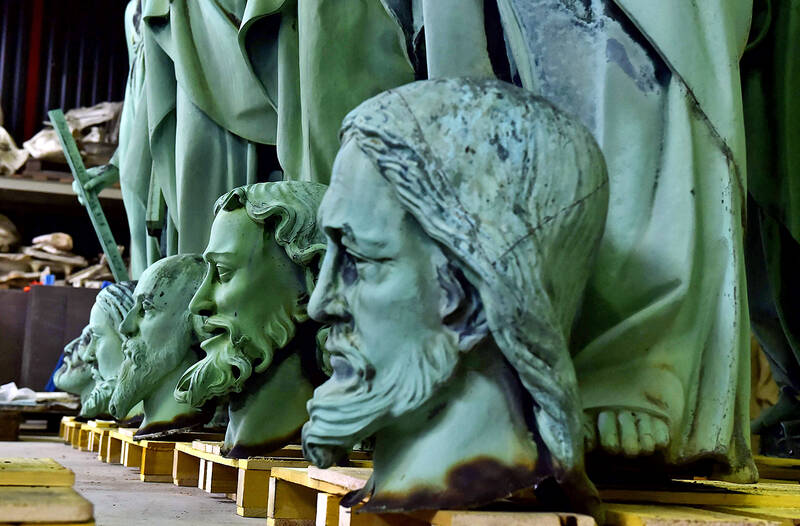The more than five-year reconstruction of Notre Dame cathedral has featured some near-miraculous recoveries, as well as several controversies. Ahead of the official reopening of the cathedral on Saturday, we look at some of the key moments:
THE SAVIORS

Photo: AFP
Paris firefighters won universal praise for their swift and decisive action on the evening of April 15, 2019, with officers later saying they thought they were only 30 minutes away from seeing the structure collapse.
Battling smoke and the risk of falling debris, they formed a human chain with church officials to evacuate the most precious artifacts and religious treasures, helping preserve most of the cathedral’s irreplaceable contents.
Others saw divine intervention in how a copper statue of a rooster that had sat atop the building’s incinerated 19th-century spire was found afterwards intact amid the scorched rubble.

Photo: AFP
Its contents — three relics, including a small piece of the Crown of Thorns supposedly worn by Jesus before his crucifixion — also survived, with the battered rooster now on display in a Paris museum. Inside the cathedral, images the day after the blaze revealed that a giant gold cross on the altar was still standing amid the still smoldering wreckage, a symbol of hope and defiance for many on a dark day for Christians and the country at large.
CONTESTED DESIGN CONTEST
French President Emmanuel Macron called the fire “an opportunity to come together” but any sense of national unity after the disaster quickly broke down.
His suggestion that an “element of modern architecture” be included in the rebuild drew immediate criticism from conservatives who demanded that the reconstruction be faithful to the last major update by architect Eugene Viollet-le-Duc in 1844.
The army general put in charge of the rebuild publicly fell out with the lead architect over the redesign, while entries for an architectural competition to select a new spire resulted in lurid headlines.
One suggestion shown by First Lady Brigitte Macron to then-culture minister Roselyne Bachelot resembled a “phallus with its base surrounded with golden balls,” Bachelot wrote in a book.
In the end, a replica of the old spire was built. Six new stained glass windows are set to be installed featuring work by contemporary artists — a modest nod to modernity and Macron’s original vision.
LEAD ROLE
Notre Dame’s roof and spire were covered by around 400 tonnes of lead, a toxic heavy metal that melted and vaporized with the heat of the fire, with some of it thought to have polluted the surrounding area.
Authorities cleaned nearby schools and advised local residents to wipe surfaces in their homes because of the risk of poisoning.
A health charity joined forces with a union and parents of local schoolchildren to lodge a criminal complaint in 2022 that accused authorities of failing to take every precaution to prevent pollution.
Charges are possible if authorities or contractors are found to have been negligent in protecting the health of residents or workers sent in to decontaminate the site, with an investigating magistrate overseeing a probe.
CAUSE UNKNOWN
The chief Paris prosecutor at the time of the fire, Remy Heitz, said shortly after the inferno that he believed that an accident such as an electrical fault or a cigarette butt was the most likely cause.
Some of the workers renovating the roof at the time of the fire were known to have smoked on site, but investigators have never been able to pinpoint the exact starting point.Speculation about an arson attack has been investigated during five years of forensic analysis, but no evidence was found.
The current chief Paris prosecutor Laure Beccuau said in April that “the closer we have got to the spot the fire started, and the more results of analyses come back, the more weight is lent to the theory of an accident.”
FEE ROW
Culture Minister Rachida Dati has proposed that visitors to the restored cathedral pay a five-euro (US$5.25) entry ticket, with the funds set to be routed to some 4,000 churches in need of repairs around France.
Charging for entry — entering Notre Dame was previously free — would bring the tourist attraction into line with St Paul’s cathedral in London or Milan’s Duomo.
But senior French church leaders have criticized the idea, with a senior bishop saying churches and cathedrals had “always been places open to all” and making money from visitors would be a “betrayal of their original vocation.”
The French state owns Notre Dame and has the final say.

The Democratic Progressive Party (DPP), Chinese Nationalist Party (KMT), and the country’s other political groups dare not offend religious groups, says Chen Lih-ming (陳立民), founder of the Taiwan Anti-Religion Alliance (台灣反宗教者聯盟). “It’s the same in other democracies, of course, but because political struggles in Taiwan are extraordinarily fierce, you’ll see candidates visiting several temples each day ahead of elections. That adds impetus to religion here,” says the retired college lecturer. In Japan’s most recent election, the Liberal Democratic Party lost many votes because of its ties to the Unification Church (“the Moonies”). Chen contrasts the progress made by anti-religion movements in

Taiwan doesn’t have a lot of railways, but its network has plenty of history. The government-owned entity that last year became the Taiwan Railway Corp (TRC) has been operating trains since 1891. During the 1895-1945 period of Japanese rule, the colonial government made huge investments in rail infrastructure. The northern port city of Keelung was connected to Kaohsiung in the south. New lines appeared in Pingtung, Yilan and the Hualien-Taitung region. Railway enthusiasts exploring Taiwan will find plenty to amuse themselves. Taipei will soon gain its second rail-themed museum. Elsewhere there’s a number of endearing branch lines and rolling-stock collections, some

Could Taiwan’s democracy be at risk? There is a lot of apocalyptic commentary right now suggesting that this is the case, but it is always a conspiracy by the other guys — our side is firmly on the side of protecting democracy and always has been, unlike them! The situation is nowhere near that bleak — yet. The concern is that the power struggle between the opposition Chinese Nationalist Party (KMT) and their now effectively pan-blue allies the Taiwan People’s Party (TPP) and the ruling Democratic Progressive Party (DPP) intensifies to the point where democratic functions start to break down. Both

This was not supposed to be an election year. The local media is billing it as the “2025 great recall era” (2025大罷免時代) or the “2025 great recall wave” (2025大罷免潮), with many now just shortening it to “great recall.” As of this writing the number of campaigns that have submitted the requisite one percent of eligible voters signatures in legislative districts is 51 — 35 targeting Chinese Nationalist Party (KMT) caucus lawmakers and 16 targeting Democratic Progressive Party (DPP) lawmakers. The pan-green side has more as they started earlier. Many recall campaigns are billing themselves as “Winter Bluebirds” after the “Bluebird Action”